The Love Post: Movies
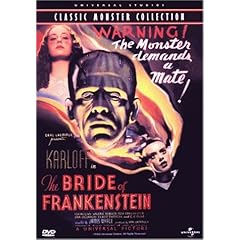 The Bride of Frankenstein (1935). I figured I should not only write about a movie I love, but a movie about love. My first thought was The Umbrellas of Cherbourg (1964), Jacques Demy’s peerless musical, the very definition of the word “bittersweet” (and a perfect date movie). But for all you lonelyhearts–buck up, we’ve all been there–I recommend James Whale’s masterpiece, a horror picture with considerable heart (and a keen wit). Throughout, the Monster (Boris Karloff, in his iconic role) is rebuffed in his attempts at human contact. When a mate (Elsa Lanchester) is hand-crafted for his comfort, he figures, reasonably, that she’s the one–but, no, she lets out a terrific “Eek!” and is done with him. Who hasn’t been on the receiving end of that “Eek!”? The Monster would go on to meet the Wolf Man, and Abbott and Costello, but I doubt he ever got over the one that got away. Do we ever? For men and for monsters, love hurts, and is an eternal mystery that we never stop trying to solve. —Bob Cashill
The Bride of Frankenstein (1935). I figured I should not only write about a movie I love, but a movie about love. My first thought was The Umbrellas of Cherbourg (1964), Jacques Demy’s peerless musical, the very definition of the word “bittersweet” (and a perfect date movie). But for all you lonelyhearts–buck up, we’ve all been there–I recommend James Whale’s masterpiece, a horror picture with considerable heart (and a keen wit). Throughout, the Monster (Boris Karloff, in his iconic role) is rebuffed in his attempts at human contact. When a mate (Elsa Lanchester) is hand-crafted for his comfort, he figures, reasonably, that she’s the one–but, no, she lets out a terrific “Eek!” and is done with him. Who hasn’t been on the receiving end of that “Eek!”? The Monster would go on to meet the Wolf Man, and Abbott and Costello, but I doubt he ever got over the one that got away. Do we ever? For men and for monsters, love hurts, and is an eternal mystery that we never stop trying to solve. —Bob Cashill
Futurama: Bender’s Big Score (2007). It took a while before I came to terms with by geekishness enough to admit that Futurama is my favorite show, and I was eagerly awaiting their first full-length movie for months. It’s practically perfect – a cleverly conceived plotline, appearances from many of the popular characters that appeared during the show’s five-year run, and a resolution that’s adequately heartwarming but doesn’t change the canon of the series. How can anything where one the main characters is a electronic-porn addicted, kleptomaniac robot fueled by alcohol possibly fail to entertain? —Zack Dennis
 A Night at the Opera (1935). Not just funny, but moving, and very subversive. Right smack dab in the middle of the Depression, the Marx Brothers were saying that not only the very rules of society needed to be changed, but that art needed to go through an upheaval as well. Gone are the old rules of aristocratic tendencies driving the cultural market. In its place was a meritocracy, as the audience turns on the overrated, European man- diva Lasparri for the younger, more talented Baroni-who happens to speak with an American accent to boot! Is it just coincidence that the opera which takes place during the climatic scene is “Il Travatore”, where the gypsies take their revenge on the oppressive monarchy? And that earlier, on the ship, the main characters have to stowaway and hide from the powers that be, but are able to get comfort and food without judgment from…a band of gypsies? Then there’s the famous stateroom scene. And the hotel room scene, and the anarchy of the final opera. And the lines–the lines!:
A Night at the Opera (1935). Not just funny, but moving, and very subversive. Right smack dab in the middle of the Depression, the Marx Brothers were saying that not only the very rules of society needed to be changed, but that art needed to go through an upheaval as well. Gone are the old rules of aristocratic tendencies driving the cultural market. In its place was a meritocracy, as the audience turns on the overrated, European man- diva Lasparri for the younger, more talented Baroni-who happens to speak with an American accent to boot! Is it just coincidence that the opera which takes place during the climatic scene is “Il Travatore”, where the gypsies take their revenge on the oppressive monarchy? And that earlier, on the ship, the main characters have to stowaway and hide from the powers that be, but are able to get comfort and food without judgment from…a band of gypsies? Then there’s the famous stateroom scene. And the hotel room scene, and the anarchy of the final opera. And the lines–the lines!:
* “You can’t fool me! There ain’t no Sanity Claus!”
* “On account of you I almost heard the opera!”
* “Have you got any milk-fed chickens?”
“Yes, sir.”
“Well, squeeze the milk out of one and bring me a glass.” —Matthew Bolin
Goodfellas (1990). I wanted to go with Akira Kurosawa’s Seven Samurai. I could have gone with Star Wars, a movie that predominated my childhood. Instead, I have to throw in with Martin Scorcese’s mighty return to form, a polemic about the perverse intoxication of power, money and influence. Watch as young Henry Hill goes from nobody to “somebody” under the tutelage of the Mob, then falls twice as hard and fast when the drug, both real and metaphorical, wears off. Compulsively watchable. —Dw. Dunphy
Shadow of a Doubt (1943). This is not only my favorite Hitchcock film (and I’ve heard that it’s his as well), it’s one of my favorite films by any director. Said to be Hitchcock’s most “American” at the time, it tells the story of a young woman (Teresa Wright) whose life is turned upside down when her suave uncle (Joseph Cotten), a suspected serial killer, comes to visit her family. I’m a huge Joseph Cotten fan and I think his chilling performance as Uncle Charlie is one of the best of his career. —Kelly Stitzel
 Bugsy (1991). It amazes me how surprised any given person will be when I declare Bugsy to be the movie I love the most. I realize there are probably a hundred deeper, more critically acclaimed films than this one to fawn over, and my choice is probably very indicative of the fact that I watch very few films compared to the amount of music I listen to. But hear me out on this one. There’s a magic combination at work here, one that has had me spellbound since it first hit the theaters in 1991. Obviously, there’s the natural on-screen spark between Warren Beatty and Annette Bening, which was no stretch for the real-life lovers who tied the knot the year after the film’s release. And then there’s the stylish big band era during which the film takes place, and the colorful mobsters who ruled back in the day. Beatty made a great mobster on screen, alternating between irresistible charm and ruthless violence with frightening ease. But that isn’t even the clincher. If you want a great mob movie, you’ll probably reach for The Godfather or Goodfellas instead. No, the special sauce in Bugsy is the title character’s vision — Ben “Bugsy” Siegel saw an oasis in the middle of the desert that was not only a way to make his life and the lives of his compatriots legitimate in the eyes of the law, but was also a monster money-making machine. It was such a grand undertaking, fraught with the roadblocks that criminal minds inevitably erect for themselves, that Siegel paid a bigger price than any of his “scammed” backers ever did. Just one visit to Vegas will tell you all you need to know about the viability of Siegel’s vision. A story like this — a man working through hostile conditions to realize a dream — dares the viewer not to love it. I obviously failed that challenge. —Michael Fortes
Bugsy (1991). It amazes me how surprised any given person will be when I declare Bugsy to be the movie I love the most. I realize there are probably a hundred deeper, more critically acclaimed films than this one to fawn over, and my choice is probably very indicative of the fact that I watch very few films compared to the amount of music I listen to. But hear me out on this one. There’s a magic combination at work here, one that has had me spellbound since it first hit the theaters in 1991. Obviously, there’s the natural on-screen spark between Warren Beatty and Annette Bening, which was no stretch for the real-life lovers who tied the knot the year after the film’s release. And then there’s the stylish big band era during which the film takes place, and the colorful mobsters who ruled back in the day. Beatty made a great mobster on screen, alternating between irresistible charm and ruthless violence with frightening ease. But that isn’t even the clincher. If you want a great mob movie, you’ll probably reach for The Godfather or Goodfellas instead. No, the special sauce in Bugsy is the title character’s vision — Ben “Bugsy” Siegel saw an oasis in the middle of the desert that was not only a way to make his life and the lives of his compatriots legitimate in the eyes of the law, but was also a monster money-making machine. It was such a grand undertaking, fraught with the roadblocks that criminal minds inevitably erect for themselves, that Siegel paid a bigger price than any of his “scammed” backers ever did. Just one visit to Vegas will tell you all you need to know about the viability of Siegel’s vision. A story like this — a man working through hostile conditions to realize a dream — dares the viewer not to love it. I obviously failed that challenge. —Michael Fortes
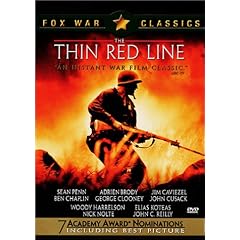 The Thin Red Line (1998). It came out the same year as Saving Private Ryan. If you didn’t see it, that’s probably your best excuse. However, the typical justification is “I tried to watch it but got bored and turned it off.” I have a vivid recollection of watching this film in the theater, with four freshly buzzed marines in the seats in front of me. As the tension built, and Nick Nolte’s Lt. Colonel Tall moved ever closer to a coronary, these green soldiers snickered to each other. An immature gesture, for sure, as Terrence Malick achieved some of the most vivid battle scenes you will ever see. This movie is like a painting and a poem intertwined, with transcendentalist narration given by virtually every character. One of the most amazing things I have discovered about this film is that Billy Bob Thornton, Martin Sheen, Gary Oldman, Bill Pullman, Viggo Mortensen, and Mickey Rourke all filmed scenes that were cut from the final edit. For actors of that caliber to have been cut to make a nearly three-hour edit truly shows how much amazing footage was filmed for this movie. Occasionally I think about those rookie recruits who shared that experience with me, often mocking the nervous energy that leads up to a battle, knowing full well that they may have seen actual combat when our nation plunged into war in 2001. Which characters did they resemble on that battlefield? —Arend Anton
The Thin Red Line (1998). It came out the same year as Saving Private Ryan. If you didn’t see it, that’s probably your best excuse. However, the typical justification is “I tried to watch it but got bored and turned it off.” I have a vivid recollection of watching this film in the theater, with four freshly buzzed marines in the seats in front of me. As the tension built, and Nick Nolte’s Lt. Colonel Tall moved ever closer to a coronary, these green soldiers snickered to each other. An immature gesture, for sure, as Terrence Malick achieved some of the most vivid battle scenes you will ever see. This movie is like a painting and a poem intertwined, with transcendentalist narration given by virtually every character. One of the most amazing things I have discovered about this film is that Billy Bob Thornton, Martin Sheen, Gary Oldman, Bill Pullman, Viggo Mortensen, and Mickey Rourke all filmed scenes that were cut from the final edit. For actors of that caliber to have been cut to make a nearly three-hour edit truly shows how much amazing footage was filmed for this movie. Occasionally I think about those rookie recruits who shared that experience with me, often mocking the nervous energy that leads up to a battle, knowing full well that they may have seen actual combat when our nation plunged into war in 2001. Which characters did they resemble on that battlefield? —Arend Anton
Roger & Me (1989). Flog Michael Moore all you want; it’s probably well-deserved, as he’s become a caricature of what he was planning to be when he started out. But this movie captured the decline of the auto industry in clear-eyed Technicolor, as well as the people it affected. It rings perfectly true 20 years on, as President Obama mulls whether or not to bail out what’s left of our automakers. —Mojo Flucke
Akira Kurosawa’s Dreams (1990). I first saw this at a film festival in San Francisco. Somehow I was expecting some bad-ass Kurosawa samurai epic like Yojimbo or Seven Samurai. I was totally unprepared for this meditative collection of vignettes — each representating an actual dream that Kurosawa had during his life. Light on dialogue and heavy on eye candy. From Kitsune weddings and nature spirits to horn-headed post-apocalyptic mutants and the horrors of war, this film covers a lot of ground. I had never seen anything like it. I fell in love with it immediately. It is a pastoral work that illustrates and defines our relationship with nature and how, for better or worse, nature always wins in the end. —Ben Wiser
 Wings of Desire (1987). When the films of the 1980s are considered, nearly every serious critic has Wings of Desire on their list. In fact, in one poll of critics, the German film finished second only to Martin Scorcese’s Raging Bull. It’s a lot more than a great film of one decade for me.
Wings of Desire (1987). When the films of the 1980s are considered, nearly every serious critic has Wings of Desire on their list. In fact, in one poll of critics, the German film finished second only to Martin Scorcese’s Raging Bull. It’s a lot more than a great film of one decade for me.
Damiel and Cassiel have been watching over Berlin since the beginning of time. They observe, unseen by those they are watching. They listen to their thoughts. One day Damiel, brilliantly played by Bruno Ganz, encounters a beautiful, but troubled trapeze artist. He is so smitten that he decides to give up his immortality so that he can experience human love. It’s all brilliant directed by Wim Wenders, who co-wrote the script with Peter Handke. There’s music and an appearance by Nick Cave, and a wonderful subplot featuring Peter Falk playing himself.
The film inspired a not-so-great Hollywood version (City of Angels), and a nearly as magical Wenders sequel called Faraway So Close. —Ken Shane
Cinema Paradiso (1988). This coming-of-age tale of a Sicilian boy’s love affair with the cinema is romantic in the best sense of the word. It teaches us that life isn’t like the movies — that parents and lovers leave and don’t come back; that the people we look up to the most aren’t necessarily perfect; that the dream of a lifetime may not be fulfilling, even if it comes true. Yet it also teaches that the emotions we feel so easily at the movies are worth reaching for in real life, and that the pursuit of love is a necessary human endeavor, even if there’s no happy ending. And in one of history’s great final scenes, director Giuseppe Tornatore plants a big, wet kiss — more like a hundred of them, actually — on film lovers everywhere. I can name a hundred movies better than Cinema Paradiso, but not one that I love more. —Jon Cummings
M*A*S*H (1970). I love the TV show (one of our local stations broadcasts the damn thing four or five times a day), but the movie is the real deal. Altman’s talent for weaving characters and stories in and out and between one another is on full display here, and the performances he captures (from the likes of Elliott Gould, Donald Sutherland, Tom Skerritt, and Robert Duvall, among many others) help the tangled episodes from knotting up. I love the interplay between Gould (as Trapper John McIntyre) and Sutherland (as Hawkeye Pierce)–their first scene together never fails to make me thirsty for martinis and Pabst Blue Ribbon–and Sally Kellerman (as “Hot Lips” Houlihan) is at once sexy and off-putting. Satirical and droll where the TV show is merely funny, M*A*S*H is a film that stands up to repeated viewings, with something new revealing itself each time you dive in. —Rob Smith
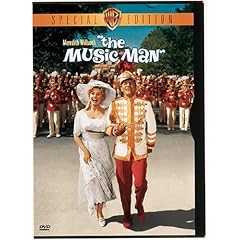 The Music Man (1962). As a child of two or three, I frequently subjected my mother to torture in the form of endless The Music Man viewings. As a woman of 24, I frequently subject my friends to torture in the form of endless The Music Man viewings. Movie musicals often take advantage of the audacity of theater and go overly campy, but the decadence of The Music Man is more than within the realm of believability. Con man “Professor Harold Hill” – whose real name is only hinted at when an old cohort calls him “Gregory” – stops into Iowa to scam the smalltownsfolk of their money by selling them the idea of a boy’s marching band that he doesn’t plan to form. In the process of playing the locals, including, of course, the lovely and obstinate Marian the Librarian, their trusting, embracing nature plays him. In reality, a con man would probably have thicker skin, but it’s Hill’s weakness for the love of a good woman that makes him human. The barbershop quartet and big-band soundtrack kicks an already great thing up a few notches. —Taylor Long
The Music Man (1962). As a child of two or three, I frequently subjected my mother to torture in the form of endless The Music Man viewings. As a woman of 24, I frequently subject my friends to torture in the form of endless The Music Man viewings. Movie musicals often take advantage of the audacity of theater and go overly campy, but the decadence of The Music Man is more than within the realm of believability. Con man “Professor Harold Hill” – whose real name is only hinted at when an old cohort calls him “Gregory” – stops into Iowa to scam the smalltownsfolk of their money by selling them the idea of a boy’s marching band that he doesn’t plan to form. In the process of playing the locals, including, of course, the lovely and obstinate Marian the Librarian, their trusting, embracing nature plays him. In reality, a con man would probably have thicker skin, but it’s Hill’s weakness for the love of a good woman that makes him human. The barbershop quartet and big-band soundtrack kicks an already great thing up a few notches. —Taylor Long
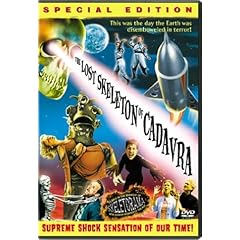 The Lost Skeleton of Cadavra (2001). This movie looks like it was made in the mid 1950s. It’s the story of a scientist and his wife who go to a cabin in the woods to study a meteorite he has found that contains the rare element atmospherium. It’s also the story of an alien couple whose spaceship crashes in the woods. They can only go back to their home planet of Marva if they can find atmospherium to power their ship. And it’s about an evil scientist who seeks to find and harness the power of the Lost Skeleton of Cadavra. Guess what the skeleton needs to bring his inert body back to life? There’s also the aliens’ escaped mutant, a woman transmutated from forest animals named Animala, and Ranger Brad, who tries to keep everybody calm even though there’s been a horrible mutilation in the woods. This is a great parody for fans of the old black and white Roger Corman cheapies, but I’ve also introduced it to people too young to even remember those movies and they enjoy it too! —Tony Redman
The Lost Skeleton of Cadavra (2001). This movie looks like it was made in the mid 1950s. It’s the story of a scientist and his wife who go to a cabin in the woods to study a meteorite he has found that contains the rare element atmospherium. It’s also the story of an alien couple whose spaceship crashes in the woods. They can only go back to their home planet of Marva if they can find atmospherium to power their ship. And it’s about an evil scientist who seeks to find and harness the power of the Lost Skeleton of Cadavra. Guess what the skeleton needs to bring his inert body back to life? There’s also the aliens’ escaped mutant, a woman transmutated from forest animals named Animala, and Ranger Brad, who tries to keep everybody calm even though there’s been a horrible mutilation in the woods. This is a great parody for fans of the old black and white Roger Corman cheapies, but I’ve also introduced it to people too young to even remember those movies and they enjoy it too! —Tony Redman
Singin’ in the Rain (1952). What a glorious feeling — Singin’ in the Rain is near perfect. It’s funny, melodramatic and full of some of the most wonderful singing and dancing you will ever see — a loving tribute to Hollywood at the dawn of sound. Gene Kelly, Donald O’Connor and Debbie Reynolds are a perfect team, Jean Hagen KILLS, and I have always loved Millard Mitchell as studio head, R.F. Simpson. Besides the great comic timing of the actors and the precise direction by Kelly and Stanley Donen, there’s that one world-famous dance number. Whenever it’s on TV, I can’t look away and it always brings a smile to my heart. —Scott Malchus
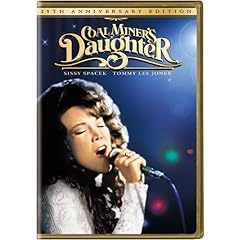 Coal Miner’s Daughter (1980). I have a real aversion to country music, but damn if I didn’t become a fan of both Sissy Spacek and Loretta Lynn after seeing this film. The rags to riches story of Loretta and her husband “Doolittle” omits a lot of the abuse “Doo” heaped on poor Loretta, but Tommy Lee Jones’ depiction struck the right counterpoint to Spacek’s portrayal of Lynn going from “Ignorant, but not stupid” teenage girl to “First lady of country music.” The film does a wonderful job of showing Lynn’s rise to superstardom from the point of view of the lead characters, and demonstrates how fame and fortune borne out of hard work and determination can lead to alienation and petty jealousies. As Loretta matures — notably under the guidance of Patsy Cline — and her star rises, Doo’s decent into heavy drinking, womanizing, and resentment may seem like a trite narrative trick if is wasn’t for Jones’ adept handling of the material. Adding to the wonderfulness of the film are the songs — sung by Spacek and Beverly D’Angelo — who make them their own by not simply parroting Lynn and Cline’s recordings, but adding their own vocal inflections that made the transitions back into dialogue seamless. —Ted Asregadoo
Coal Miner’s Daughter (1980). I have a real aversion to country music, but damn if I didn’t become a fan of both Sissy Spacek and Loretta Lynn after seeing this film. The rags to riches story of Loretta and her husband “Doolittle” omits a lot of the abuse “Doo” heaped on poor Loretta, but Tommy Lee Jones’ depiction struck the right counterpoint to Spacek’s portrayal of Lynn going from “Ignorant, but not stupid” teenage girl to “First lady of country music.” The film does a wonderful job of showing Lynn’s rise to superstardom from the point of view of the lead characters, and demonstrates how fame and fortune borne out of hard work and determination can lead to alienation and petty jealousies. As Loretta matures — notably under the guidance of Patsy Cline — and her star rises, Doo’s decent into heavy drinking, womanizing, and resentment may seem like a trite narrative trick if is wasn’t for Jones’ adept handling of the material. Adding to the wonderfulness of the film are the songs — sung by Spacek and Beverly D’Angelo — who make them their own by not simply parroting Lynn and Cline’s recordings, but adding their own vocal inflections that made the transitions back into dialogue seamless. —Ted Asregadoo
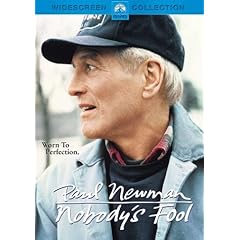 Nobody’s Fool (1994). As a filmgoing teen, I — like many other red-blooded American males — spent most of my movie money on pictures that included plenty of action, lots of explosions, and preferably a healthy serving of endlessly quotable one-liners, ideally delivered by a stubble-faced, profusely bleeding Bruce Willis. It was Willis, in fact, who led me to see Nobody’s Fool; I hadn’t yet developed an appreciation for the movie’s real star, Paul Newman and had never read (or even heard of) the wonderful book it was adapted from, but I’d made a habit of watching all of Willis’ movies since the beginning, so off I went. (Yes, I even watched all of Billy Bathgate. And Sunset, God help me.) Nobody’s Fool does include a ton of one-liners — many of them delivered by Willis — but it surprised me on almost every other front, delivering a tender, thoughtful rumination on aging and the cumulative cost of the decisions we make, as well as the endless possibility for redemption. I’ve watched this movie more times than I can count, will yet watch it many times more, and will most likely always feel like I learned something new when it’s over. —Jeff Giles
Nobody’s Fool (1994). As a filmgoing teen, I — like many other red-blooded American males — spent most of my movie money on pictures that included plenty of action, lots of explosions, and preferably a healthy serving of endlessly quotable one-liners, ideally delivered by a stubble-faced, profusely bleeding Bruce Willis. It was Willis, in fact, who led me to see Nobody’s Fool; I hadn’t yet developed an appreciation for the movie’s real star, Paul Newman and had never read (or even heard of) the wonderful book it was adapted from, but I’d made a habit of watching all of Willis’ movies since the beginning, so off I went. (Yes, I even watched all of Billy Bathgate. And Sunset, God help me.) Nobody’s Fool does include a ton of one-liners — many of them delivered by Willis — but it surprised me on almost every other front, delivering a tender, thoughtful rumination on aging and the cumulative cost of the decisions we make, as well as the endless possibility for redemption. I’ve watched this movie more times than I can count, will yet watch it many times more, and will most likely always feel like I learned something new when it’s over. —Jeff Giles

![Reblog this post [with Zemanta]](http://img.zemanta.com/reblog_e.png?x-id=4d17709e-2411-47c8-9ff5-83ace37114cd)
Comments